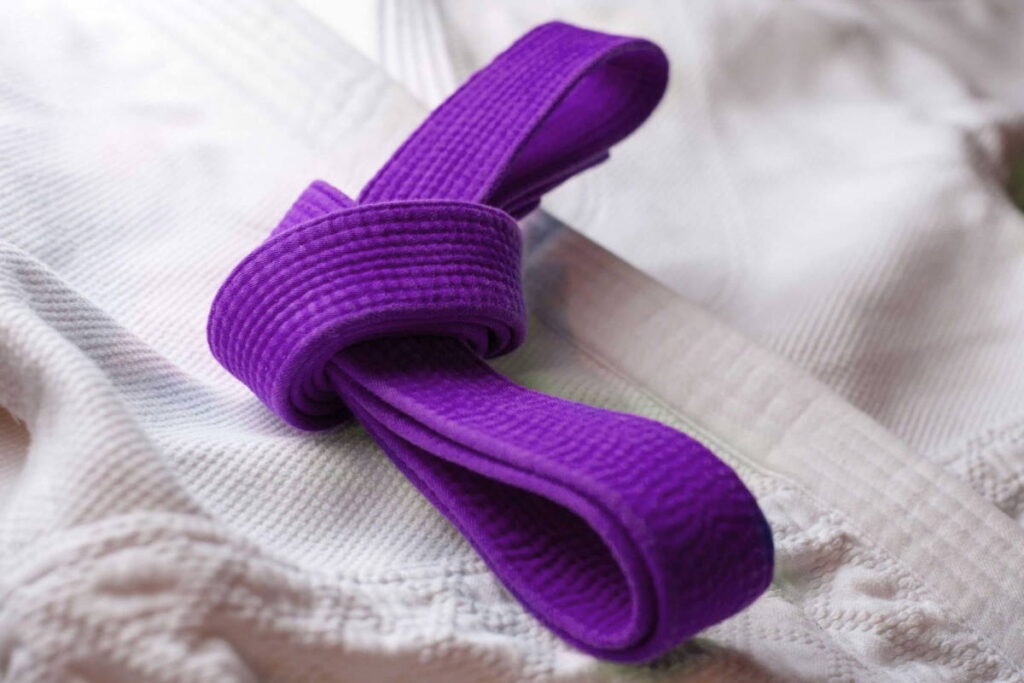The progress that you make in Jiu-Jitsu is marked with colored belts, just like with any other martial arts. No matter what level you’re currently at, you’re probably wondering what allows you to move on to the next level and how long you need to be on each level.
To reach the status of a black belt, you might need 10 years and more, depending on how long you practice every week. Due to the fact that each level takes time, you might end up feeling discouraged. However, patience is a strong aspect of Jiu-Jitsu!
Jiu-Jitsu is one of the most effective martial arts due to the policy of conservatism it implements. What this means is that students are never promoted before they’re at a skill level that’s higher or equal than others who are on that level that they will compete against.
Before we continue with our guide, we want you to keep in mind that Jiu-Jitsu is all about enjoying the moment instead of racing to climb the levels quickly!

Jiu-Jitsu Belt Ranks
The Jiu-Jitsu belt ranks aren’t complicated. There are different colors of belts that signify different levels of experience, dedication, and knowledge of the students.
Below, we’re going to look at the belt ranks specifically in Brazilian Jiu-Jitsu and explain what each one means!
White Belt
The belt where every student of Jiu-Jitsu starts learning the foundation for everything they’ll practice is the white belt. The white belt is the beginning rank for all Brazilian Jiu-Jitsu students. Any student that’s new to this martial arts will hold a white belt.
There isn’t a minimum age requirement to acquire this belt. The goals for this belt are to choose one technique to master and to know common guard passes and submission. The usual time that’s spent at this level by students is between six months to two years.
Blue Belt
The blue belt, unlike the previous one, comes with a minimum age requirement. There’s no way to earn a Brazilian Jiu-Jitsu blue belt unless you’re at least 16 years old.
When it comes to the blue belt, there’s also a requirement in terms of the time spent at that level. Usually, Brazilian Jiu-Jitsu requires a student to remain at a blue belt level for at least two years.
In reality, it takes between one to three years for most people to move on to the next level. Students spend most of their time on this level since it’s considered the most important of all of the learning belts.
At this level, Brazilian Jiu-Jitsu students undertake many hours of practice to learn to execute the moves in an efficient manner, and they gain a wide breadth of technical knowledge.
Purple Belt
One of the most fun and exceptional belts out of all the Brazilian Jiu-Jitsu belt ranks is the purple belt. That’s because it signifies that you’ve managed to acquire enough knowledge and techniques to start discovering and having fun, even though there are still a lot of things to learn and to process!
Getting a purple belt means that the student has given a significant part of their life to the martial art and that they take it seriously, and it’s usually seen as a midpoint of the career of a student.
The minimum age to acquire this belt is at least 16 years old. In terms of time, the official period of time you need to spend on this level is one to two years on this belt. A purple belt level practitioner is usually considered qualified to instruct other lower-ranked students.
The goals of the purple belt are that the student is comfortable using and passing advanced guard variants, such asdeep-half,spider,de la riva, etc. They should also be able to execute multiple combination attacks, several submissions from all mount positions, and have a dangerous guard game.
Brown Belt
A student must remain a brown belt for at least one year, even though in practice it usually takes longer.
In order to acquire a brown belt level, the student must be at least 18 years old. The reason for this is because this belt brings lots of responsibilities and it carries a lot of weight.
However, people don’t mind staying on the brown belt for a long time since it’s not a level where people typically rush things.
Black Belt
The Brazilian Jiu-Jitsu black belt denotes an expert level of practical and technical skill, and it’s the highest level belt given by the Jiu-Jitsu Federation.
The minimum age limit to receive this belt is at least 19 years old; however, the time that needs to be spent at this level is very strict. Brazilian Jiu-Jitsu requires the student to remain a degree black belt for a minimum of 31 years!
The goals of the black belt are for the student to consider cross-training in the martial arts, continue to learn and grow, focus on keeping their body and mind in shape, and know that the journey never really ends.
Coral Belt
When the seventh degree is reached by a Brazilian jiu-jitsu black belt practitioner, they are awarded a red and black belt that is also known as the coral belt. A practitioner must remain a black and red belt for a minimum of seven years.
This belt is usually awarded to people who have made a big impact on Brazilian Jiu-Jitsu and who are very experienced.
Red Belt
The highest rank that is awarded to any practitioner of Brazilian Jiu-Jiuts is the ninth-degree red belt. This belt is reserved for those whose fame and influence have taken them to the highest point of this martial art.
If a practitioner is 19 years old when they receive their black belt, the earliest they can get their red belt is the age of 67. Those who hold this belt are often known as the grandmasters of this martial art.
Final Thoughts
The grading and teaching methods are what give Brazilian Jiu-Jitsu the success it’s largely attributed to, as well as fitness, techniques, and drills. One of the key foundations of grading is the skill level and performance of the individual.
As a result, instead of theory, the emphasis is put more on the performance of the martial art, and the students are accordingly graded.
We hope that this guide has helped you understand Brazilian Jiu-Jitsu better and the steps it takes to advance to each level. For more information, please feel free to keep exploring our site!

